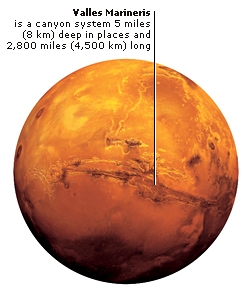DK Science: Mars
The fourth planet from the Sun, Mars is one of Earth’s closest neighbours. Mars has a slight atmosphere (mainly carbon dioxide), and ice caps at the poles. Channels on the surface suggest that water may have flowed on the planet in the past. Although freezing now, some astronomers think that Mars might once have been warmer and supported some form of life.
Table 13. ESSENTIAL DATA
| Diameter at equator | 6,794 km (4,222 miles) |
| Average distance from Sun | 227.9 million km (141.6 million miles) |
| Orbital period | 687 days |
| Rotation period | 24.63 hours |
| Mass (Earth=1) | 0.11 |
| Gravity (Earth=1) | 0.38 |
| Average surface temperature | -63°C (-81°F) |
| Number of moons | 2 (Phobos and Deimos) |

Mars appears red because of the iron oxide (rust) in the rocks and dust on its surface. Features such as the Valles Marineris canyon can be seen through the thin atmosphere. There are also sandy deserts, large cratered regions, channels, and volcanoes.

Clouds ring the summit of Mars’ gigantic volcano, Olympus Mons (Mount Olympus). Some 600 km (400 miles) across at the base, Olympus Mons rises to a height of 24 km (15 miles). This makes it by far the biggest volcano we know in the Solar System. It is located near the equator, close to three other large volcanoes on a bulge called the Tharsis Ridge.
Astronomers believe that the two tiny moons of Mars were asteroids that Mars captured in its gravity long ago. The largest moon is Phobos, an irregular lump around 26 km (16 miles) in diameter. Deimos is even smaller – only about 16 km (10 miles) wide. Both moons are covered with craters and are thought to be made up of rock rich in carbon.
